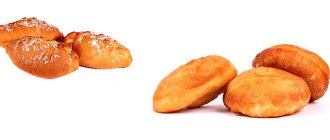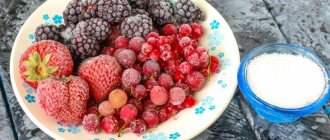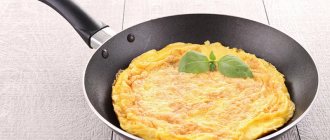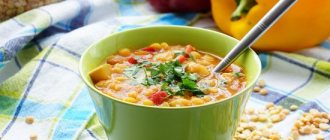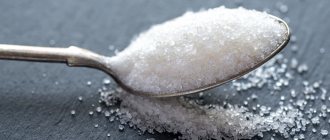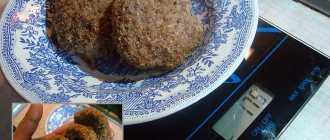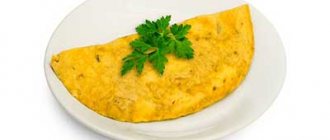Calorie content of pies
What do most of us associate pies with? With a happy childhood, holidays with my grandmother in the village and a lot of memorable and definitely pleasant moments.
Pies occupy one of the main places among traditional dishes of Russian cuisine. This is an indispensable attribute of festive feasts and a frequent guest at the everyday table. Pies are a high-calorie dish, but despite this, they remain popular even in an era of universal desire for slimness. Hearty, aromatic and tasty - the pies will not leave even the most persistent “fighters” with excess calories indifferent.
How calorie-rich the pies will be depends on several factors:
- what dough they are made from and what flour was used as a basis;
- how they were prepared;
- what is included in the filling.
The dough for pies can be very diverse: yeast and puff pastry, mixed with kefir or water. Yeast pies are much higher in calories than those made from yeast-free dough. Products made from wheat flour have the highest energy value compared to analogues made from rye, oatmeal or any other flour.
There are two ways to prepare pies: they can be baked or fried. Baked pies are lower in calories. Fried dough products add to their considerable calorie content the calorie content of the oil that was used for frying.
The filling for pies can be as different as the housewife’s imagination allows: potatoes and cabbage, meat and mushrooms, cottage cheese and jam. The pies are sweet and salty, with simple and combined fillings - you can’t list everything.
If we compare the calorie content of the filling, then using cabbage for it will allow you to prepare lower-calorie pies compared to potato filling, which have lower energy value than any type of sweet pies.
Do you pay attention to your diet and don’t need extra calories, but still want to pamper yourself and your family with pies? Opt for baked pies with cabbage.
The calorie content of 100 grams of cabbage pies prepared according to the following recipe is 175 kcal.
How to cook them? There are no special secrets here.
To prepare the dough you will need:
- wheat flour - 1 kg;
- water - 400 ml;
- vegetable oil - 70 ml;
- dry yeast - 10 grams;
- salt - 2 teaspoons;
- sugar - 2 tablespoons.
Calorie content of pies with potatoes
Potato pies are in great demand. But the calorie content of potato pies cannot be called low, since it is 300 kcal per hundred grams of product. We are talking here about a baked pie with potatoes. If we talk about the fried form, then in this case, the calorie content of pies with potatoes will be several times higher. Here the calorie content is determined by the type of dough.
Depending on the type of dough, the calorie content in potato pies will increase or decrease. Butter dough made with milk and eggs is much more nutritious than simple dough made with water. In addition, it is best to bake pies in the oven - in this case there will be fewer carcinogens and calories.
Dietary properties:
What calorie content does a pie fried with meat have, what dietary properties does it have, all this is of great interest to those who lead a healthy lifestyle and monitor their health and figure. So we will try to answer these questions in the following article.
So:
Meat is a first-class protein product, that is, it contains essential amino acids in quantities favorable for the human body. Some of them are difficult for the human body to obtain through the consumption of other foods.
That is why meat is the most important product in a balanced balanced diet. The energy value of 100 g of meat is 105–489 kcal, depending on the type, fatness and age of the animal, as well as the part of the carcass.
The biological value of meat proteins significantly exceeds the biological value of milk casein, which is taken as the standard for determining this indicator. Meat proteins are easily digestible; they rank second in terms of absorption rate after fish and dairy proteins. Meat is most valued for its content of B vitamins and proteins.
The nutritional value of animal meat is mainly due to the presence of complete proteins rich in essential amino acids.
Calorie content of egg pie
Speaking about the calorie content of a pie with an egg, one cannot help but say that it also depends on the type of dough. But you can reduce the calorie content of the egg pie by using low-fat milk and durum wheat flour for the dough.
It should also be said that the calorie content of a pie with an egg fried in a frying pan will be several times higher than the calorie content of a pie with an egg baked in the oven. Thus, the calorie content of a baked pie is only 240 kcal per hundred grams of product, and the calorie content of a fried pie in a frying pan is 340 kcal per hundred grams of product. As you can see, the difference in calories is large.
Calorie content of baked pies (per 100 g):
- Calorie content of pies with cabbage - 214 kcal
- Calorie content of pies with potatoes - 235 kcal
- Calorie content of pies with egg - 204 kcal
- Calorie content of meat pies - 256 kcal
- Calorie content of pies with mushrooms - 192 kcal
- Calorie content of fish pies - 180 kcal
- Calorie content of apple pies - 177 kcal
- Calorie content of pies with cottage cheese - 209 kcal
- Calorie content of pies with jam - 240 kcal
Calorie content of fried pies (per 100 g):
- Calorie content of pies with cabbage - 263 kcal
- Calorie content of pies with potatoes - 276 kcal
- Calorie content of pies with egg - 260 kcal
- Calorie content of meat pies - 342 kcal
- Calorie content of pies with mushrooms -226 kcal
- Calorie content of fish pies - 215 kcal
- Calorie content of apple pies - 205 kcal
- Calorie content of pies with cottage cheese - 217 kcal
- Calorie content of pies with jam - 289 kcal
Recipe for baked pies with cottage cheese. Calorie, chemical composition and nutritional value.
Nutritional value and chemical composition of “Baked pies with cottage cheese.”
The table shows the nutritional content (calories, proteins, fats, carbohydrates, vitamins and minerals) per 100 grams of edible portion.
| Nutrient | Quantity | Norm** | % of the norm in 100 g | % of the norm in 100 kcal | 100% normal |
| Calorie content | 264.9 kcal | 1684 kcal | 15.7% | 5.9% | 636 g |
| Squirrels | 11.3 g | 76 g | 14.9% | 5.6% | 673 g |
| Fats | 5.8 g | 56 g | 10.4% | 3.9% | 966 g |
| Carbohydrates | 41.9 g | 219 g | 19.1% | 7.2% | 523 g |
| Organic acids | 0.4 g | ~ | |||
| Alimentary fiber | 1.8 g | 20 g | 9% | 3.4% | 1111 g |
| Water | 46.7 g | 2273 g | 2.1% | 0.8% | 4867 g |
| Ash | 1.17 g | ~ | |||
| Vitamins | |||||
| Vitamin A, RE | 3.1 mcg | 900 mcg | 0.3% | 0.1% | 29032 g |
| Retinol | 0.003 mg | ~ | |||
| Vitamin B1, thiamine | 0.109 mg | 1.5 mg | 7.3% | 2.8% | 1376 g |
| Vitamin B2, riboflavin | 0.111 mg | 1.8 mg | 6.2% | 2.3% | 1622 g |
| Vitamin B4, choline | 39.45 mg | 500 mg | 7.9% | 3% | 1267 g |
| Vitamin B5, pantothenic | 0.294 mg | 5 mg | 5.9% | 2.2% | 1701 g |
| Vitamin B6, pyridoxine | 0.155 mg | 2 mg | 7.8% | 2.9% | 1290 g |
| Vitamin B9, folates | 36.363 mcg | 400 mcg | 9.1% | 3.4% | 1100 g |
| Vitamin B12, cobalamin | 0.413 mcg | 3 mcg | 13.8% | 5.2% | 726 g |
| Vitamin C, ascorbic acid | 0.06 mg | 90 mg | 0.1% | 150000 g | |
| Vitamin D, calciferol | 0.004 mcg | 10 mcg | 250000 g | ||
| Vitamin E, alpha tocopherol, TE | 2.965 mg | 15 mg | 19.8% | 7.5% | 506 g |
| Vitamin H, biotin | 3.938 mcg | 50 mcg | 7.9% | 3% | 1270 g |
| Vitamin K, phylloquinone | 0.4 mcg | 120 mcg | 0.3% | 0.1% | 30000 g |
| Vitamin RR, NE | 2.9556 mg | 20 mg | 14.8% | 5.6% | 677 g |
| Niacin | 0.97 mg | ~ | |||
| Macronutrients | |||||
| Potassium, K | 96.67 mg | 2500 mg | 3.9% | 1.5% | 2586 g |
| Calcium, Ca | 49.99 mg | 1000 mg | 5% | 1.9% | 2000 g |
| Silicon, Si | 2 mg | 30 mg | 6.7% | 2.5% | 1500 g |
| Magnesium, Mg | 16.78 mg | 400 mg | 4.2% | 1.6% | 2384 g |
| Sodium, Na | 206.64 mg | 1300 mg | 15.9% | 6% | 629 g |
| Sera, S | 98.61 mg | 1000 mg | 9.9% | 3.7% | 1014 g |
| Phosphorus, P | 107.2 mg | 800 mg | 13.4% | 5.1% | 746 g |
| Chlorine, Cl | 344.78 mg | 2300 mg | 15% | 5.7% | 667 g |
| Microelements | |||||
| Aluminium, Al | 540.6 mcg | ~ | |||
| Bor, B | 18.5 mcg | ~ | |||
| Vanadium, V | 45 mcg | ~ | |||
| Iron, Fe | 0.787 mg | 18 mg | 4.4% | 1.7% | 2287 g |
| Yod, I | 3.64 mcg | 150 mcg | 2.4% | 0.9% | 4121 g |
| Cobalt, Co | 1.5 mcg | 10 mcg | 15% | 5.7% | 667 g |
| Manganese, Mn | 0.3697 mg | 2 mg | 18.5% | 7% | 541 g |
| Copper, Cu | 76.23 mcg | 1000 mcg | 7.6% | 2.9% | 1312 g |
| Molybdenum, Mo | 9.696 mcg | 70 mcg | 13.9% | 5.2% | 722 g |
| Nickel, Ni | 1.1 mcg | ~ | |||
| Tin, Sn | 6.66 mcg | ~ | |||
| Selenium, Se | 12.376 mcg | 55 mcg | 22.5% | 8.5% | 444 g |
| Strontium, Sr | 5.31 mcg | ~ | |||
| Titanium, Ti | 5.5 mcg | ~ | |||
| Fluorine, F | 42.26 mcg | 4000 mcg | 1.1% | 0.4% | 9465 g |
| Chromium, Cr | 1.73 mcg | 50 mcg | 3.5% | 1.3% | 2890 g |
| Zinc, Zn | 0.4898 mg | 12 mg | 4.1% | 1.5% | 2450 g |
| Digestible carbohydrates | |||||
| Starch and dextrins | 33.95 g | ~ | |||
| Mono- and disaccharides (sugars) | 7.8 g | max 100 g | |||
| Galactose | 0.016 g | ~ | |||
| Lactose | 0.563 g | ~ | |||
| Essential amino acids | 2.4 g | ~ | |||
| Arginine* | 0.263 g | ~ | |||
| Valin | 0.323 g | ~ | |||
| Histidine* | 0.181 g | ~ | |||
| Isoleucine | 0.326 g | ~ | |||
| Leucine | 0.595 g | ~ | |||
| Lysine | 0.47 g | ~ | |||
| Methionine | 0.154 g | ~ | |||
| Methionine + Cysteine | 0.188 g | ~ | |||
| Threonine | 0.262 g | ~ | |||
| Tryptophan | 0.059 g | ~ | |||
| Phenylalanine | 0.3 g | ~ | |||
| Phenylalanine+Tyrosine | 0.603 g | ~ | |||
| Nonessential amino acids | 3.209 g | ~ | |||
| Alanin | 0.144 g | ~ | |||
| Aspartic acid | 0.325 g | ~ | |||
| Glycine | 0.09 g | ~ | |||
| Glutamic acid | 1.061 g | ~ | |||
| Proline | 0.65 g | ~ | |||
| Serin | 0.267 g | ~ | |||
| Tyrosine | 0.303 g | ~ | |||
| Cysteine | 0.034 g | ~ | |||
| Sterols (sterols) | |||||
| Cholesterol | 7.06 mg | max 300 mg | |||
| beta sitosterol | 10 mg | ~ | |||
| Saturated fatty acids | |||||
| Saturated fatty acids | 1 g | max 18.7 g | |||
| 12:0 Lauric | 0.001 g | ~ | |||
| 14:0 Miristinovaya | 0.001 g | ~ | |||
| 16:0 Palmitinaya | 0.316 g | ~ | |||
| 18:0 Stearic | 0.207 g | ~ | |||
| 20:0 Arakhinovaya | 0.015 g | ~ | |||
| 22:0 Begenovaya | 0.035 g | ~ | |||
| Monounsaturated fatty acids | 1.393 g | min 16.8 g | 8.3% | 3.1% | |
| 16:1 Palmitoleic | 0.005 g | ~ | |||
| 18:1 Oleic (omega-9) | 1.199 g | ~ | |||
| Polyunsaturated fatty acids | 3.294 g | from 11.2 to 20.6 g | 29.4% | 11.1% | |
| 18:2 Linolevaya | 2.996 g | ~ | |||
| 18:3 Linolenic | 0.002 g | ~ | |||
| Omega-6 fatty acids | 3.2 g | from 4.7 to 16.8 g | 68.1% | 25.7% |
The energy value of baked pies with cottage cheese is 264.9 kcal.
- Serving = 75 g (198.7 kcal)
Primary Source: Created in the application by the user. Read more.
** This table shows the average levels of vitamins and minerals for an adult. If you want to know the norms taking into account your gender, age and other factors, then use the “My Healthy Diet” application.
Properties of pies
Few people write about the benefits of fried foods, because there is nothing to write about. The same is true with pies fried in a large amount of oil. Due to the oxidation of fats, free radicals appear, which provoke the development of atherosclerosis and all kinds of cardiovascular diseases. Carcinogens evaporating from burning oil (heated many times) cause cancer.
Also, excessively fatty fried foods have a detrimental effect on the gastrointestinal tract and well-being in general, causing a feeling of heaviness, and “hits” the liver.
But if you replace frying with baking in the oven, then everything will change dramatically. “Correct” carbohydrates, broken down during the fermentation process, saturate the body with the necessary energy, yeast sticks normalize digestion, forming beneficial microflora in the intestines. Nutrients help increase the body's resistance and immunity. Moreover, baked pies help eliminate carcinogens and toxins. It is an excellent source of calories for children and workers with heavy physical activities. The benefits of baked pies are further enhanced by various fillings: meat, fish, berries, vegetables, herbs, boiled eggs, mushrooms, etc.
Correct usage
You need to eat pies wisely, keeping in mind some rules:
- Pies contain a large amount of carbohydrates. During the day, these carbohydrates are digested and spent during your activity. If a large amount of them enters the body after 18 hours (in the form of a pie eaten at night), then they will be converted into adipose tissue.
- For the filling, choose fresh natural vegetables or lean meat - chicken or turkey. For sweet pies, low-fat cottage cheese is a good filling option.
- The dough tends to stick together and interfere with the passage of food through the intestines. Therefore, after eating the pies, it is advisable to make the next meal light and, if possible, include a liquid dish in it.
Combination of pies with the diet menu
Why don’t nutritionists recommend regularly including a pie with potatoes or cabbage on the menu? The main harm is caused not by the calorie content of the product, but by the high content of simple carbohydrates. Simple carbohydrates quickly penetrate the blood. They are absorbed much faster than the body receives energy from them. As a result, the sugar level rises sharply and an insulin reaction begins. The process leads to fat accumulation.
How to combine eating pie with losing weight? When losing weight, it is recommended to temporarily exclude the dish from the diet, but at the stage of maintaining body weight, it is not forbidden to eat this tasty product on rare occasions.
The basic rule is that flour-based products must be cooked in the oven; fried foods are not compatible with dietary nutrition.
How to eat pies correctly while following a diet?
- You should not snack on cabbage or potato pie in the evening. In this case, all calories and carbohydrates will go to the stomach and thighs.
- You can eat the pie for breakfast or as a snack before lunch. The main time to have a snack with this dish is before 14.00.
- The number of pies should not exceed more than one.
- Preference is best given to a lean baked pie with cabbage. It has fewer calories than the same product with potatoes.
To reduce the calorie content of flour dishes with potatoes or cabbage, you should cook them at home. The use of yeast-free unleavened dough is good for diet. You can use low-fat milk, olive oil, and wholemeal flour in the recipe. Store-bought products often contain margarine or palm oil.
How many calories are in 1 potato pie?
Pies are made from various types of dough. But if we are talking about fried or baked treats, then yeast-based dough is most often taken as the basis. The ideal filling is boiled potatoes. True, this vegetable is called the second bread and supporters of proper nutrition do not recommend combining potatoes with dough, but does this stop true connoisseurs of pies?
So, how many calories are in a baked potato pie? The nutritional value of pies cooked in the oven will be approximately 235 kilocalories per 100 g of product. But one medium-sized pie contains up to 175 kilocalories.
On a note! As you can see, the treat is too high in calories. But baked baked goods have slightly lower nutritional value compared to their fried pies.
How many calories are in a fried potato pie? A 100-gram serving will contain approximately 275 kilocalories. And the calorie content of one pie will be too high - approximately 206 kilocalories.
The high calorie content of fried pies is due to the fact that they are simmered in refined vegetable oil. The dough is impregnated with it, as a result of which the amount of carbohydrates and fats increases, and therefore the energy value.
On a note! If you want to find an alternative to pies with potato filling, you can prepare your favorite pastries with fish fillet or apple filling. Such dishes cannot be called low-calorie, but still their nutritional value will be lower.
